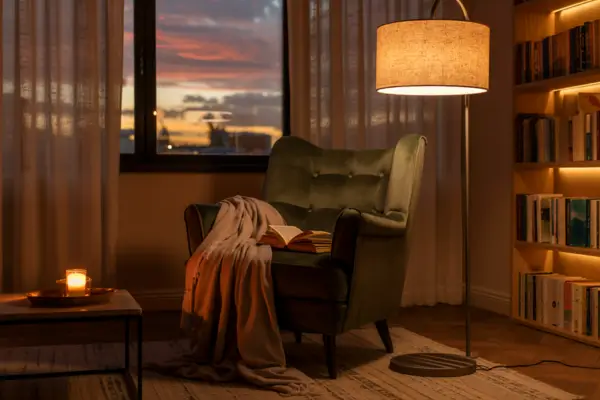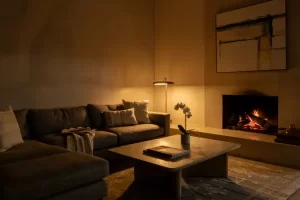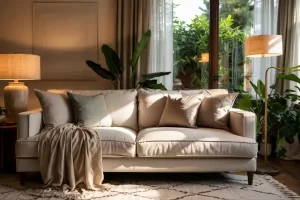There’s a magical moment in every day when natural light softens, colors grow deeper, and shadows stretch across our interiors—this is dusk. Often overlooked in design planning, dusk offers an opportunity to create emotionally rich, visually dynamic spaces that shift in tone and function. Rather than relying solely on daytime brightness or nighttime coziness, designing for dusk allows you to embrace the subtle in-between—a time of transformation where rooms can truly come alive. In this article, we’ll explore how to design interiors that respond beautifully to this transitional light, using color, materials, lighting, and layout to create harmony between day and night. Whether you’re setting the mood in a living room, bedroom, or reading nook, the dusk hour holds unique potential for ambiance, relaxation, and sensory connection. Let’s dive into the soft power of designing with dusk in mind.
Understanding the Dusk Effect in Interior Spaces
Dusk, the time just after sunset, brings a gradual change in natural light—soft, diffused, and lower in intensity. This ambient shift transforms how we perceive color, texture, and space. Shadows lengthen, highlights become more subtle, and a golden or bluish cast may tint the room. Designers who work with this in mind can use dusk to introduce emotion, mood, and movement into a space. Unlike bright daylight, dusk offers calm and introspection, which can be enhanced through strategic design decisions. Understanding this effect is the first step to unlocking a room’s twilight personality.
Why Design for Transition, Not Just Function
Most interior design plans focus on two light extremes: full daylight and artificial night lighting. But the transition between them—dusk—is often ignored. Designing for this window of time means your space can adapt and evolve as the light changes, offering a richer, layered experience. Dusk design encourages mindfulness, slows the pace, and helps people wind down naturally. It turns your home into a narrative—a story that shifts with the sky.
Choosing Colors That Embrace the Dusk Light
The colors you choose for a dusk-oriented space must interact gracefully with changing light. As the sun sets, colors shift in temperature and intensity. Bright whites can feel harsh or cold, while warm, muted tones become richer and more welcoming. Think in layers: earthy neutrals, soft terracotta, muted sage, dusty rose, and deep indigo all respond well to evening light. These tones absorb and reflect the twilight glow in ways that create comfort and calm. Consider painting a wall in a slightly darker tone to anchor the room and let dusk light dance around it.
Using Paint Finishes to Enhance Twilight Mood
Beyond color, the finish of your paint plays a crucial role in how it behaves at dusk. Matte and eggshell finishes diffuse light softly, reducing glare and enhancing shadow play. Avoid glossy finishes in dusk-focused spaces, as they can create harsh reflections and disrupt the serenity. Walls with texture—like limewash or brushed plaster—interact with low-angle light in captivating ways, producing subtle variations and adding depth to the environment. These surfaces reflect dusk not as light, but as mood.
Accent Colors for Emotional Impact
Accent tones in dusk-inspired design are not meant to dominate. Instead, they should stir emotion. Soft gold, amber, moss green, and deep plum can be used in accessories, textiles, or even small furniture pieces to create focal points that glow as daylight fades. These colors enhance the room’s emotional depth, offering warmth, elegance, and personality at the edge of night.
Layered Lighting: Bringing Depth to Dusk Hours
When natural light begins to fade, layered lighting becomes essential. The goal is not to overpower the room with brightness, but to enhance the softness that dusk provides. Layered lighting involves combining different types of light sources—ambient, task, and accent—to create a flexible and atmospheric space. The right balance ensures your room maintains its warmth and charm as evening sets in. It allows areas to glow gently rather than flood with light, mirroring the slow rhythm of twilight.
Ambient Lighting That Respects the Mood
Ambient lighting forms the base. Instead of harsh overhead lights, opt for dimmable ceiling fixtures, wall sconces, or cove lighting with warm bulbs (2700K or lower). These options let you adjust the intensity as dusk deepens. Consider indirect lighting that bounces off walls or ceilings—this spreads illumination without sharp contrasts, maintaining a peaceful vibe throughout the space.
Task Lighting with a Soft Touch
While dusk invites calm, functional spaces still require clarity. Choose table lamps or floor lamps with linen or frosted glass shades to diffuse light. Position them near reading chairs, desks, or kitchen prep zones—but always ensure they contribute to the overall mood. Adjustable brightness and flexible necks allow for precise control without disrupting the dusk-inspired design.
Accent Lights That Tell a Story
Accent lighting highlights the room’s personality. Use LED strips under shelves, candles in alcoves, or backlit mirrors to create focal points that come alive after sunset. Soft lighting on artwork, architectural details, or textured walls enhances their presence at twilight. These finishing touches draw the eye and add emotional resonance—perfect for a space designed to evolve with the sky.
Materials and Textures That Reflect Evening Light
Materials play a key role in how a space feels during dusk. As light softens, certain textures and surfaces come alive, interacting with the glow in subtle and compelling ways. Choose materials that invite touch and visual warmth—those that deepen in tone or shimmer softly under low light. Natural elements work especially well, grounding the space in comfort and organic beauty.
Fabrics That Add Warmth and Movement
Opt for fabrics like linen, wool, velvet, or cotton gauze, which interact beautifully with dusk light. Linen curtains, for example, filter light in a diffused, graceful manner, while velvet throws or cushions add tactile richness and depth. Layering different textures—like a chunky knit over a smooth sheet—creates contrast and coziness, perfect for transitioning from day to night in comfort.
Surfaces That Glow, Not Glare
Wood, clay, natural stone, and matte metals like brushed brass or aged bronze respond to evening light with subtle elegance. Avoid highly reflective materials like polished chrome or glass tabletops that might disrupt the dusk ambiance. Instead, choose finishes that absorb and diffuse light—like matte ceramic, honed marble, or oiled wood—to promote harmony and quiet luxury.
Texture as a Tool for Sensory Connection
As the sun sets, our sense of touch becomes more pronounced. Texture gives your space dimension and emotional richness—whether it’s a woven rug underfoot, a hand-thrown pottery vase, or the grain of a wood bench. These details ground us in the present and enhance the connection between space and mood during twilight hours.
Designing Layouts That Capture the Magic of Twilight
The way you arrange a room can influence how it receives and transforms dusk light. Layout isn’t just about traffic flow—it’s also about framing moments. Strategic placement of furniture, open space, and visual focal points helps the room tell a story as the light shifts from day to evening. The layout should feel calm, natural, and responsive to the fading sun.
Oriented Seating for Light Appreciation
Place seating areas where people can witness the transition of light. A chair angled near a window, a bench along a west-facing wall, or a reading nook bathed in indirect light all create moments of pause. These spaces become invitations to unwind, reflect, and be present. Incorporate floor cushions or poufs to encourage flexible seating that adapts to the evening mood.
Clearing Visual Pathways for Flow and Calm
Visual clarity is essential in dusk-oriented design. Avoid overcrowding. Leave breathing space around key features like windows, lamps, or artwork. Let the eye travel naturally from one soft-lit element to another. Open layouts and minimal clutter allow shadows to stretch and shift, enhancing the poetic quality of twilight within your interior.
Highlighting Zones That Transition with the Light
Think of your space in zones: a lounge that glows with low light, a dining area that invites slow meals, or a hallway that becomes moody and contemplative. Use furniture arrangement and lighting to distinguish each zone while maintaining a unified flow. This allows the room to evolve with the light, offering different experiences as day slips into night.
Conclusion
Designing for dusk isn’t just a lighting choice—it’s an emotional strategy. By embracing the softness of twilight, you invite stillness, presence, and beauty into your home. Every surface, shadow, and glow contributes to a mood that welcomes reflection and comfort. Whether through warm textures, layered lighting, or mindful layouts, your space can mirror the peaceful rhythm of the evening sky. Let your home evolve with the day, and you’ll find that the most magical moments are often bathed in the quiet luxury of dusk.




